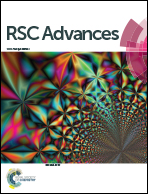TD-DFT calculations of UV absorption bands and their intensities in the spectra of some tetrahydroquinolines†
Abstract
A detailed analysis of the MOs involved in electronic transitions in UV spectra as well as a conformational study of 1-benzenesulfonyl-1,2,3,4-tetrahydroquinoline (BSTHQs) derivatives have been carried out using the TD-DFT (B3LYP/6-31+G(d,p)) method. Based on experimental solvent effects and theoretical investigations the long-wavelength bands have been assigned to π → π* transitions caused by HOMO–LUMO intramolecular charge transfer from the tetrahydroquinoline fragment (THQ) to the benzenesulfonyl moiety (BS). Nevertheless, for the NO2 derivative the HOMO–LUMO transition was found to be forbidden. In this case the long-wavelength band has been associated to an n → π* transition. Good correlation of theoretical and experimental data for the energy transitions and the molar extinction coefficients of the compounds studied has been obtained and is presented for the first time.


 Please wait while we load your content...
Please wait while we load your content...